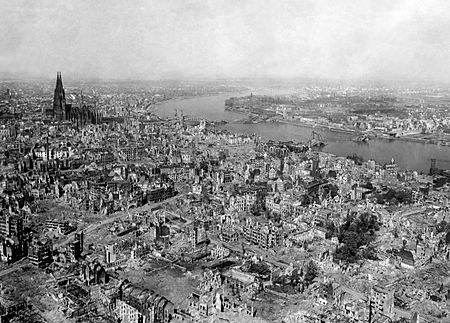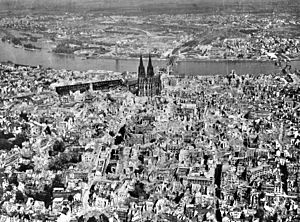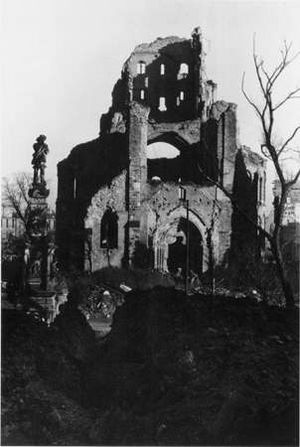Bombing of Cologne in World War II facts for kids
The German city of Cologne was bombed many times by the Allied forces during World War II. The Royal Air Force (RAF) from Britain carried out all 262 air raids. They dropped over 34,711 tons of bombs on the city. Sadly, 20,000 civilians in Cologne died because of these bombings.
The first air raid alarms in Cologne happened in early 1940. British bombers flew overhead, but the first actual bombing was on May 12, 1940. A very big attack on May 30/31, 1942, was the first time 1,000 bombers were used in one raid.
The First 1,000 Bomber Raid
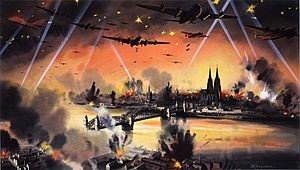
The RAF's first ever "1,000 bomber raid" happened over Cologne on the night of May 30/31, 1942. This huge attack was called Operation Millennium. It had two main goals:
- The Allies hoped that such a massive attack would cause enough damage to make Germany stop fighting. They also wanted to hurt German morale, which means their spirit and confidence.
- These raids were also good for propaganda. They showed the Allies were strong. The head of RAF Bomber Command, Arthur Harris, believed in using many bombers to attack Germany. In 1941, Bomber Command wasn't very accurate. Some people wanted to break up the force. Harris wanted to prove to the War Cabinet (the government leaders) that Bomber Command could help win the war.
At that time, Bomber Command only had about 400 planes ready for battle. They were also changing from older, two-engine planes to newer, more powerful four-engine planes. These new planes included the Handley Page Halifax and Avro Lancaster. To get 1,000 planes, Harris used planes and pilots from training units. He also asked for 250 planes from RAF Coastal Command and Flying Training Command.
However, just before the raid, the Royal Navy said no to letting Coastal Command planes join. The Navy leaders felt that showing off was not as important as fighting German U-boats in the Battle of the Atlantic. Harris quickly found 49 more planes with student pilots and instructors. In the end, 1,047 bombers took part. This was two and a half times more planes than any previous RAF raid. 58 of these bombers were from Polish units. Besides the bombers attacking Cologne, 113 other planes flew "intruder" missions. They bothered German night-fighter airfields.
Cologne was not Harris's first choice. He wanted to bomb Hamburg. But bad weather made Hamburg a poor choice. A scientist named Basil Dickins suggested Cologne instead. It was within range of a new navigation system called GEE.
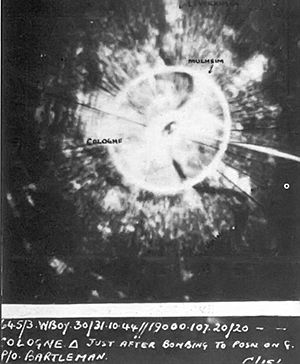
This raid was the first time the "bomber stream" tactic was used. Many of the methods used in this raid became standard for Bomber Command for the next two years. Some parts of it were even used until the end of the war. The idea was that so many bombers flying close together would overwhelm German night fighters. The German system for guiding their fighters from the ground, called ground-controlled interception, would not be able to handle them all. This would keep the number of bombers shot down low.
The new GEE navigation system allowed bombers to fly a set path at a specific time and height. British night bombing had been going on for months. Experts could guess how many bombers would be lost to enemy night fighters and flak (anti-aircraft guns). They also knew how many would crash into each other. To lose fewer planes, the bombers flew in a tight group. German night fighter controllers could only direct a few attacks per hour. Flak gunners could not focus on all targets at once.
Earlier in the war, a four-hour mission was normal. For this raid, all the bombers flew over Cologne and dropped their bombs within 90 minutes. The first plane arrived at 12:47 AM on May 31. The goal was to drop so many bombs so quickly that Cologne's fire brigades would be overwhelmed. This would cause huge fires, like those in London during the Blitz by the Luftwaffe.
During the raid, 868 planes bombed the main target. Another 15 planes bombed other places. They dropped a total of 1,455 tons of bombs. Two-thirds of these were incendiary bombs, which start fires. Two and a half thousand separate fires began. German firefighters called 1,700 of them "large." Firefighters and wide streets stopped the fires from joining into a firestorm. However, most of the damage came from fire, not from the explosions themselves.
Many buildings were damaged. 3,330 non-residential buildings were destroyed. 2,090 were badly damaged, and 7,420 were slightly damaged. This made a total of 12,840 damaged buildings. 2,560 of these were factories or businesses. Buildings completely destroyed included: 7 government buildings, 14 public buildings, 7 banks, 9 hospitals, 17 churches, 16 schools, 4 university buildings, 10 postal and railway buildings, 10 historic buildings, 2 newspaper offices, 4 hotels, 2 cinemas, and 6 department stores. The only military place damaged was the flak barracks.
Homes were also badly hit. 13,010 homes were destroyed, 6,360 were badly damaged, and 22,270 were slightly damaged. Most of these were apartments in larger buildings. A photographer named Hermann Claasen recorded the destruction from 1942 until the end of the war. He showed his photos in an exhibition and a book in 1947.
The RAF lost 43 planes during the raid. This was 3.9% of the 1,103 bombers sent. 22 planes were lost over or near Cologne. 16 were shot down by flak, four by night fighters, and two crashed into each other. Two Bristol Blenheim light bombers were lost attacking night fighter airfields. Flying Officer Leslie Thomas Manser was given a special medal, the Victoria Cross, after he died. He sacrificed himself so his crew could escape the plane.
| Group | Type of Aircraft | Number of Aircraft |
|---|---|---|
| No. 1 Group RAF | 156 Vickers Wellington medium bombers | 156 |
| No. 3 Group RAF | 134 Wellington 88 Short Stirling heavy bombers |
222 |
| No. 4 Group RAF | 131 Handley Page Halifax heavy bombers 9 Wellington 7 Armstrong Whitworth Whitley medium bombers |
147 |
| No. 5 Group RAF | 73 Avro Lancaster heavy bombers 46 Avro Manchester medium bombers 34 Handley Page Hampden medium bombers |
153 |
| No. 91 (Operational Training) Group | 236 Wellington 21 Whitley |
257 |
| No. 92 (Operational Training) Group | 63 Wellington 45 Hampden |
108 |
| Flying Training Command | 4 Wellington | 4 |
Timeline of Bombings
| Date | Bomber force | Notes |
|---|---|---|
| May 17/18, 1940 | RAF | Six Wellington bombers attacked railway yards. |
| February 13/14, 1942 | RAF | 39 planes faced ice and clouds. Bombing results were not good. |
| March 13/14, 1942 | RAF | 135 planes took part. This raid killed 62 people and injured 84. 237 fires started. The RAF thought this raid was five times more effective than recent ones. This was the first successful raid using the GEE navigation system. The RAF lost one Avro Manchester plane. |
| April 5/6, 1942 | RAF | 263 planes were involved. |
| April 22/23, 1942 | RAF | 69 planes. |
| April 27/28, 1942 | RAF | 97 planes. |
| May 30/31, 1942 | RAF | 868 planes bombed Cologne during the first 1,000 bomber raid (1,047 planes total). They carried over 3,000 tons of bombs. |
| May 31, 1942 | RAF | 5 de Havilland Mosquito planes from No. 105 Squadron RAF took photos to see the damage. |
| May 31/June 1, 1942 | RAF | Two planes flew over. It was cloudy, so no bombs were dropped. Both planes returned safely. |
| June 1, 1942 | RAF | 2 Mosquitoes flew a small raid to distract German forces. |
| July 26, 1942 | RAF | 3 Mosquitoes flew a small raid. |
| August 10, 1942 | RAF | A single Mosquito flew a small raid, dropped bombs, and returned. |
| August 25, 1942 | RAF | 4 Mosquitoes flew small raids to Germany. One went to Cologne. Three completed their mission and bombed. One was lost. |
| September 2, 1942 | RAF | 1 Mosquito flew a small raid, bombed, and returned. |
| September 2, 1942 | RAF | 2 Mosquitoes flew a small raid, bombed through clouds, and returned. |
| September 7, 1942 | RAF | 1 Mosquito flew a small raid, bombed through clouds, and returned. No damage was recorded on the ground. |
| October 15/16, 1942 | RAF | 289 planes. |
| January 22/23, 1943 | RAF | This was the first raid on Cologne using the "Oboe" blind bombing system. Two Mosquitoes damaged 55 houses, killed 5 people, and injured 22. This showed that a few bombers with electronic help could do as much damage as 100 bombers in bad weather. |
| February 2/3, 1943 | RAF | 161 planes. |
| February 14/15, 1943 | RAF | 243 planes. |
| February 25/26, 1943 | RAF | 6 Mosquitoes flew to the Ruhr area as a distraction. 13 people were killed in Cologne. |
| February 26/27, 1943 | RAF | 427 planes. |
| June 11/12, 1943 | RAF | One Mosquito as part of a distraction raid. |
| June 13/14, 1943 | RAF | 2 Mosquitoes bombed Cologne as one of several small raids. |
| June 16/17, 1943 | RAF | 212 planes. |
| June 17/18, 1943 | RAF | Two Mosquitoes bombed Cologne as one of several small raids. |
| June 19/20, 1943 | RAF | Six Mosquitoes flew to Cologne, Duisburg, and Düsseldorf. |
| June 22/23, 1943 | RAF | Four Mosquitoes as a distraction raid. |
| June 23/24, 1943 | RAF | Three Mosquitoes on a small raid. |
| June 28/29, 1943 | RAF | 608 planes. |
| July 2/3, 1943 | RAF | Three Mosquitoes on a small raid. |
| July 3/4, 1943 | RAF | 653 planes attacked Cologne's industrial area. A new German unit, Jagdgeschwader 300, used a new tactic called Wilde Sau with single-engine fighters for the first time. German fighters used searchlights and fires to help them see. They claimed to shoot down 12 planes. To avoid shooting down their own planes, anti-aircraft guns fired below a certain height, and fighters operated above it. |
| July 5/6, 1943 | RAF | Four Mosquitoes on a small raid. |
| July 6/7, 1943 | RAF | Four Mosquitoes on a small raid. |
| July 7/8, 1943 | RAF | 4 Mosquitoes on a small raid. |
| July 8/9, 1943 | RAF | 288 planes. |
| July 13/14, 1943 | RAF | Two Mosquitoes on a distraction raid dropped target markers. |
| July 25/26, 1943 | RAF | 3 Mosquitoes on a distraction raid. |
| August 4/5, 1943 | RAF | 5 Mosquitoes bombed Cologne and Duisburg through clouds. |
| August 4/5, 1943 | RAF | 5 Mosquitoes bombed Cologne and Duisburg through clouds. These were the only flights that night. No planes were lost. |
| August 6/7, 1943 | RAF | 8 Mosquitoes flew to Cologne and Duisburg. These were the only flights over Germany that night. All 8 returned safely. |
| August 7/8, 1943 | RAF | 4 Mosquitoes on a small raid. |
| August 11/12, 1943 | RAF | 8 Mosquitoes on a small raid. |
| August 29/20, 1943 | RAF | 4 Oboe-equipped Mosquitoes, with another 4 to Duisburg, on small raids. One Mosquito was lost. |
| September 1, 1943 | RAF | 8 Mosquitoes were sent to Cologne and Duisburg. No Mosquitoes were lost. |
| September 4/5, 1943 | RAF | 8 Mosquitoes were sent to Cologne and Duisburg. No Mosquitoes were lost. |
| September 13/14, 1943 | RAF | 5 Oboe-equipped Mosquitoes, with another 5 to Duisburg, on small raids. No Mosquitoes were lost. |
| September 18/19, 1943 | RAF | 5 Mosquitoes on a small raid. No Mosquitoes were lost. |
| September 24/25, 1943 | RAF | 8 Mosquitoes flew to Cologne and Düsseldorf on small raids. No Mosquitoes were lost. |
| September 26/27, 1943 | RAF | 4 Mosquitoes flew to Cologne on a small raid. No Mosquitoes were lost. |
| September 26/27, 1943 | RAF | 8 Mosquitoes attacked Cologne and Gelsenkirchen on small raids. These were the only Bomber Command flights that night. No Mosquitoes were lost. |
| October 2/3, 1943 | RAF | 8 Mosquitoes flew to Cologne and Gelsenkirchen on distraction raids. No planes were lost on these raids. |
| October 3/4, 1943 | RAF | 12 Oboe-equipped Mosquitoes bombed the Knapsack power station near Cologne. No planes were lost. |
| October 13/14, 1943 | RAF | 4 Mosquitoes flew to Cologne on a small raid. No Mosquitoes were lost. |
| October 20/21, 1943 | RAF | 28 Mosquitoes flew to Berlin, Cologne, Brauweiler, and Emden. 2 Mosquitoes were lost. |
| December 22, 1943 | USAAF | VIII Bomber Command Mission 163: 1 B-17 dropped two 2,000-pound bombs. No one was hurt. |
| January 1/2, 1944 | RAF | 1 Mosquito on a distraction raid returned safely. |
| January 4/5, 1944 | RAF | 2 Mosquitoes on a small raid, both returned safely. |
| February 2/3, 1944 | RAF | 3 Mosquitoes on a small raid, all returned safely. |
| March 16/17, 1944 | RAF | 8 Mosquitoes on a distraction raid, all returned safely. |
| March 17/18, 1944 | RAF | 28 Mosquitoes bombed Cologne, all returned safely. |
| March 21/22, 1944 | RAF | 27 Mosquitoes bombed Cologne, all returned safely. |
| March 29/30, 1944 | RAF | 4 Mosquitoes on a distraction raid, all returned safely. |
| March 29/30, 1944 | RAF | 34 Mosquitoes flew distraction raids to Aachen, Cologne, and Kassel, all returned safely. |
| April 1944 | USAAF | 303rd Bomb Group tried to use a GB-1 Glide Bomb, but it failed. |
| July 18/19, 1944 | RAF | 6 Mosquitoes on a distraction raid. The RAF made several attacks that night, including on oil plants and railway junctions. |
| October 14, 1944 | VIII Bomber Command | Mission 677: As part of a continuous bombing operation, Pathfinder planes attacked Cologne's railway yards. |
| 1944-10-15 | The 486th Bomb Group bombed Cologne. | |
| October 17, 1944 | 8th AF | Mission 681: 1,338 bombers and 811 fighters were sent to the Cologne area. Many B-17s bombed railway yards. |
| February 12/13, 1945 | RAF | 3 Mosquitoes on H2S radar tests. No planes were lost. |
| March 2, 1945 | RAF | In the last RAF raid on Cologne, 858 planes bombed in two waves. Only 15 planes in the second wave dropped their bombs. This daylight raid in good weather caused "highly destructive" damage. |
| March 2, 1945 | USAAF | A single B-17 bombed Cologne as a target of opportunity. |
| March 5, 1945 | 9th Tactical U.S. Army Air Force fighters dropped leaflets in the Cologne-Bonn area. | |
| March 6, 1945 | American troops captured Cologne. |
See also
- The Blitz – German air raids on British cities. At least 40,000 people died, including 57 nights of raids on London.
- Baedeker Blitz – Air raids on English cities important for their culture or history, not military targets.
- German bombing of Rotterdam
- Bombing of Dresden in World War II
- Bombing of Guernica – A German/Italian air raid that caused international anger.
- Bombing of Tokyo (10 March 1945) – The "Operation Meetinghouse" firebombing raid on Tokyo on March 9/10, 1945.


